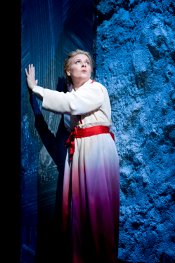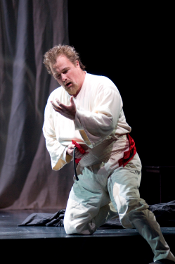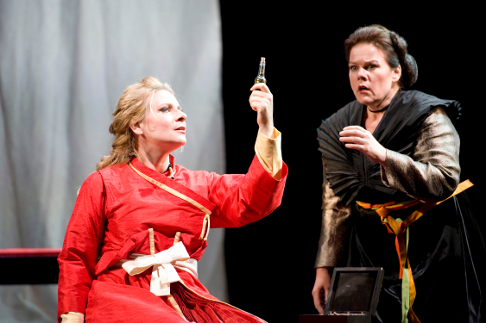![Annalena Persson (Isolde) and Clifton Forbis (Tristan) [Photo by Rozarii Lynch]](http://www.operatoday.com/10%20Tristan%20rl%20324.png)
15 Aug 2010
Tristan in Seattle
Seattle, the city of software and Starbucks, is also a summer site for serious Wagnerites.
English Touring Opera are delighted to announce a season of lyric monodramas to tour nationally from October to December. The season features music for solo singer and piano by Argento, Britten, Tippett and Shostakovich with a bold and inventive approach to making opera during social distancing.
This tenth of ten Live from London concerts was in fact a recorded live performance from California. It was no less enjoyable for that, and it was also uplifting to learn that this wasn’t in fact the ‘last’ LfL event that we will be able to enjoy, courtesy of VOCES8 and their fellow vocal ensembles (more below …).
Ever since Wigmore Hall announced their superb series of autumn concerts, all streamed live and available free of charge, I’d been looking forward to this song recital by Ian Bostridge and Imogen Cooper.
Although Stile Antico’s programme article for their Live from London recital introduced their selection from the many treasures of the English Renaissance in the context of the theological debates and upheavals of the Tudor and Elizabethan years, their performance was more evocative of private chamber music than of public liturgy.
Evidently, face masks don’t stifle appreciative “Bravo!”s. And, reducing audience numbers doesn’t lower the volume of such acclamations. For, the audience at Wigmore Hall gave soprano Elizabeth Llewellyn and pianist Simon Lepper a greatly deserved warm reception and hearty response following this lunchtime recital of late-Romantic song.
For this week’s Live from London vocal recital we moved from the home of VOCES8, St Anne and St Agnes in the City of London, to Kings Place, where The Sixteen - who have been associate artists at the venue for some time - presented a programme of music and words bound together by the theme of ‘reflection’.
'Such is your divine Disposation that both you excellently understand, and royally entertaine the Exercise of Musicke.’
‘And there was war in heaven: Michael and his angels fought against the dragon; and the dragon fought and his angels, And prevailed not; neither was their place found any more in heaven … that old serpent … Satan, which deceiveth the whole world: he was cast out into the earth, and his angels were cast out with him.’
There was never any doubt that the fifth of the twelve Met Stars Live in Concert broadcasts was going to be a palpably intense and vivid event, as well as a musically stunning and theatrically enervating experience.
‘Love’ was the theme for this Live from London performance by Apollo5. Given the complexity and diversity of that human emotion, and Apollo5’s reputation for versatility and diverse repertoire, ranging from Renaissance choral music to jazz, from contemporary classical works to popular song, it was no surprise that their programme spanned 500 years and several musical styles.
The Academy of St Martin in the Fields have titled their autumn series of eight concerts - which are taking place at 5pm and 7.30pm on two Saturdays each month at their home venue in Trafalgar Square, and being filmed for streaming the following Thursday - ‘re:connect’.
The London Symphony Orchestra opened their Autumn 2020 season with a homage to Oliver Knussen, who died at the age of 66 in July 2018. The programme traced a national musical lineage through the twentieth century, from Britten to Knussen, on to Mark-Anthony Turnage, and entwining the LSO and Rattle too.
With the Live from London digital vocal festival entering the second half of the series, the festival’s host, VOCES8, returned to their home at St Annes and St Agnes in the City of London to present a sequence of ‘Choral Dances’ - vocal music inspired by dance, embracing diverse genres from the Renaissance madrigal to swing jazz.
Just a few unison string wriggles from the opening of Mozart’s overture to Le nozze di Figaro are enough to make any opera-lover perch on the edge of their seat, in excited anticipation of the drama in music to come, so there could be no other curtain-raiser for this Gala Concert at the Royal Opera House, the latest instalment from ‘their House’ to ‘our houses’.
"Before the ending of the day, creator of all things, we pray that, with your accustomed mercy, you may watch over us."
The doors at The Metropolitan Opera will not open to live audiences until 2021 at the earliest, and the likelihood of normal operatic life resuming in cities around the world looks but a distant dream at present. But, while we may not be invited from our homes into the opera house for some time yet, with its free daily screenings of past productions and its pay-per-view Met Stars Live in Concert series, the Met continues to bring opera into our homes.
Music-making at this year’s Grange Festival Opera may have fallen silent in June and July, but the country house and extensive grounds of The Grange provided an ideal setting for a weekend of twelve specially conceived ‘promenade’ performances encompassing music and dance.
There’s a “slide of harmony” and “all the bones leave your body at that moment and you collapse to the floor, it’s so extraordinary.”
“Music for a while, shall all your cares beguile.”
The hum of bees rising from myriad scented blooms; gentle strains of birdsong; the cheerful chatter of picnickers beside a still lake; decorous thwacks of leather on willow; song and music floating through the warm evening air.
![Annalena Persson (Isolde) and Clifton Forbis (Tristan) [Photo by Rozarii Lynch]](http://www.operatoday.com/10%20Tristan%20rl%20324.png)
Seattle, the city of software and Starbucks, is also a summer site for serious Wagnerites.
Best known for its regular Ring cycle, the Seattle Opera presents other Wagner operas in the off years. The high quality of this summer’s performance of Tristan und Isolde is a tribute to the company’s seriousness of purpose. While perhaps not quite a match for its legendary 1998 Tristan, in which Jane Eaglen and Ben Heppner debuted in the title roles, it nonetheless presents as strong a cast as one is likely to encounter anywhere today.
Clifton Forbis is that rarest of singers: a genuine dramatic Heldentenor whose clarion top rests on a dark baritonal base. If his voice seems a bit less supple than in his impressive 2005 Geneva performance (available on DVD), it is now more solidly grounded. On August 4, despite lingering indisposition, he displayed hardly a single moment of technical insecurity. While somewhat restrained in Act I, perhaps by design, he trumpeted the Act III high notes with apparent ease—as if, in the Birgit Nilsson tradition, he could sing it all over again. (The performance was shorn of the Act II “Tag und Nacht” segment, a standard Seattle cut, but Act III was performed complete—more than many Tristans sing.) Throughout there were moments of genuine musical and dramatic insight. While those with a historical perspective might quibble, calling here and there for clearer diction, subtler phrasing, gentler pianos, warmer timbre, or deeper psychological insight—who today sings a finer Tristan?
 Annalena Persson as Isolde
Annalena Persson as Isolde
Much anticipation surrounded the American debut of Annalena
Persson. The young Swedish soprano sang the role of Isolde to acclaim at
the Welsh National Opera in 2006, where Seattle impresario Speight Jenkins
signed her up. (The local press hints that she is slated as Seattle’s
2013 Brünnhilde as well.) Young, blonde, comely and, by Wagnerian standards,
slim, Persson looks the part. Her silvery voice has edge and brilliance that
can project, despite some lack of warmth and heft, through a Wagnerian
orchestra. At times she is a thrilling interpreter, particularly at moments of
anger and excitement, such as the Act I Narration and Curse—especially
where the orchestration is light. But the role of Isolde overstretches her
vocal resources. On sustained (particularly rising) tones in the upper middle
part of the voice, the voice weakens and the vibrato widens dangerously. The
“Liebestod,” almost entirely comprised of such passages sung
against full orchestra, was thus anti-climactic.
The secondary roles were all taken by Seattle favorites, to great effect. Stephen Milling nearly stole the show with a moving König Marke. His rich bass effortlessly filled the hall, and his German diction was exemplary. Margaret Jane Wray is gaining attention these days, consistently singing major roles at the Met. To judge from her Brangäne here, the spreading fame is well-deserved. Hers is a soprano approach to this Zwischenfach role, slightly steely at the top, but clearly projected and delivered, with plenty of volume. Greer Grimsley, Seattle’s resident Wotan, made a more convincing Kurwenal for being understated and elegant wherever possible. Jason Collins plays a forceful Melot, Simeon Esper a sweet Shepherd/Sailor, and Barry Johnson a fine Steersman.
 Clifton Forbis as Tristan
Clifton Forbis as Tristan
Seattle’s Principal Guest Conductor Asher Fisch is not
one to pepper this score with excessive accelerandos, overweighty accents, or
bloated brass. He strives instead for a consistent mood of classical restraint,
brilliantly achieved through smooth line, subtle detail, smooth blend, and
transparent textures. (Connoisseurs might note also the innovative use of open
strings and Wagner’s specified Holztrompete
in Act III.) The orchestra, once past some botched entrances in the prelude,
played splendidly.
Stage director Peter Kazaras conceives Acts II and III as Tristan and Isolde’s final hallucination. That is, the potion is indeed the death potion Isolde ordered, and from then on we share the images that pass through the lovers’ minds in the moments before they expire. The inspiration is Ambrose Bierce’s famous short story, “An Occurrence at Owl Creek Bridge.” This concept offers many potential insights into text and score. It promises to link the opera’s two central concepts, love and death, in a unique way, underscores Tristan and Isolde’s uncanny separation from all that goes on around them, with everything important taking place within their minds, and highlights the opera’s uniquely distorted sense of time.
 Annalena Persson as Isolde and Margaret Jane Wray as Brangäne
Annalena Persson as Isolde and Margaret Jane Wray as Brangäne
Ultimately the production fails to fully engage this demanding concept, though the stage direction, set design, and costumes (the latter two being the work of Robert Israel) display numerous virtues. On the positive side, a semi-transparent curtain draws the viewer gently into the dream world of each act, as if falling asleep (in the best possible sense!). The gloomy semi-abstract unit set, with a window at the back into reality, is visually neutral but acoustically resonant—a virtue too often neglected these days. The blocking of Act II, in which Tristan and Isolde slowly follow one another across a dark stage, like Orpheus and Eurydice, evokes their ghostly state between worlds. Similarly consistent with the concept, Kurwenal is never killed but simply recedes from Tristan’s consciousness. Tristan and Isolde’s costumes shift from mortal red to half-red, and finally to pure transfigured white, as if the blood is slowly draining from them. The extensive use of computer-aided lighting effects, a Seattle innovation with this production, is evocative. Tristan sings his first lines in Act II while apparently fully encased in a large slab of solid stone—a striking effect in itself, but also one that highlights that Isolde is summoning him only in her mind. (It would be even more effective if maintained for more than a few lines.) Other coups de théâtre include a glittering shower for the potion, and a giant, glowing holographic candle for the Act II light.
Yet much else is a jumble, undermining the production’s core concept. Semi-realistic elements—large wrapped paintings, a tree, furniture, and the little model ship (mandatory, it seems, in contemporary Tristan productions)—coexist uneasily with abstract ones, such as laser-like red cords and a “stage within a stage” curtain behind which characters intermittently disappeared. This is hallucinatory, perhaps, but incoherent. The blocking at the end of Act I, and throughout Act II, tells us less than it might about the subjective experience of passing from day into night: It is not clear, for example, why the “dying” Tristan and Isolde are separated at the start of Act II, then again reunited. Nor does the costuming and comportment of secondary characters clearly delineate their status from the subjective perspective of the dying couple: One would expect a more fundamental change in how they are perceived after the Tristan and Isolde imbibe poison. In the end, too much of the production is static, even blandly realistic, in a classic stand-and-sing manner.
In the intermissions and on line, one encounters considerable criticism of this production for being too radical. I believe it is, on balance, too conservative. Readers of my recent commentary on the Stuttgart Ring know I can be critical of the excesses of Wagnerian Regietheater. Yet this production of Tristan might profitably have been more radical and rigorously intellectual—more konsequent, a German critic might well have said. The production is insightful as it stands, but a future revival might give Kazaras a second chance to realize its promising central idea more starkly.
Andrew Moravcsik